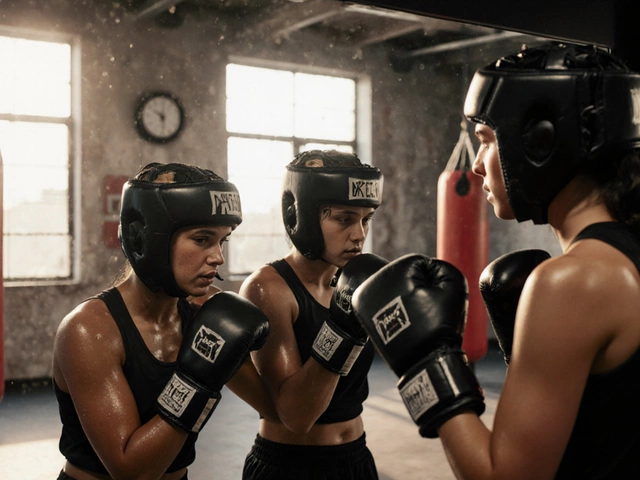Essential Equipment Female Athletes Need for Peak Performance

In the realm of sports, the right equipment can significantly influence an athlete's performance and comfort. For female athletes, having gear tailored specifically to their needs is not just a luxury—it's a necessity. Women have unique physiological characteristics that inform the design and functionality of their sports equipment.
It's crucial to prioritize well-fitting apparel and footwear, as these form the foundation of athletic performance. Protective gear that accommodates feminine body structures also plays a pivotal role in ensuring safety during high-intensity sports. Moreover, advancements in technology have ushered in innovative training and recovery tools that can empower female athletes to reach new heights.
Let’s explore the essential sports equipment every female athlete should consider to enhance their craft, stay protected, and continue pushing their boundaries.
Apparel and Footwear
When it comes to female athletes, apparel and footwear choices are critical not just for performance, but also for health and comfort. One of the enduring challenges has been the lack of availability and variety of female-specific sportswear. Until a few decades ago, women in sports had to make do with unisex or male-oriented clothing, which often led to discomfort and hindered performance. Thankfully, substantial advances have led to the development of sportswear that adequately reflects and respects the female body.
The design of sports bras is a prime example of technology meeting necessity. A well-fitted sports bra isn't just about comfort; it's about protecting sensitive tissues, mitigating bounce, and reducing back strain. It's a garment borne from a deep understanding of anatomy. According to recent research, wearing the wrong sports bra can lead to as much as a 35% reduction in performance efficiency due to discomfort and distraction. This statistic highlights the vital nature of appropriate sports equipment in the everyday life of a female athlete.
When addressing footwear, the considerations are equally important. Women's feet have different biomechanical needs compared to men's, such as a higher arch and narrower heel. Women in sports require shoes that support these unique features, ultimately preventing injuries like plantar fasciitis and shin splints. Major brands have noted these differences and started offering gender-specific collections. This effort to cater to specifics doesn't just make the athlete's journey easier—it's a testament to the evolving acceptance and understanding of female athlete needs.
Athletic clothing has also become an arena for material innovation. From moisture-wicking fabrics to UV protection and compression gear, the right apparel enhances athlete performance and recovery. Compression garments, for instance, have been noted to improve oxygen flow to the muscles, which may accelerate recovery times and reduce the risk of injury. A study by the Journal of Sports Science highlighted that many athletes reported a 4% improvement in perceived recovery speed when wearing compression clothing post-training.
"The right fit can make a world of difference. It's not just about looking good, it's about feeling supported and capable," says Dr. Emily Waters, a sports physiologist who focuses on gender differences in sports performance.
The evolution of apparel and footwear represents a broader shift toward inclusivity in sports, encouraging participation and performance among female athletes. As the industry continues to innovate, there's hope that the barriers female athletes face will further diminish, unlocking potential and paving the way for new generations of women in sports.
Protective Gear
When it comes to safeguarding the well-being of female athletes, protective gear is absolutely indispensable. The right protective equipment can make all the difference between a safe workout and the risk of injury. Interestingly, not all protective gear is made with women in mind, which underscores the need for specifically engineered gear. In sports like soccer, rugby, and hockey, protective equipment such as shin guards and mouthguards are crucial. However, they do more than just prevent bruises; these pieces can significantly reduce the risk of fractures and concussions.
One crucial aspect often overlooked is the impact of ill-fitting protective gear. Equipment not tailored for women could lead to discomfort or even restrict movement, which could impair performance levels on the field. That's why manufacturers have begun producing gear designed to align with the unique anatomy of women. Take, for example, different chest protectors made for various sports. They take into account the structure and size requirements of women's bodies, offering comfort without sacrificing safety.
Helmets are another critical component. Women's lacrosse and ice hockey are sports where the right helmet can spell the difference between a minor and a catastrophic injury. These helmets should offer a snug fit, have a solid outer shell, and include enough padding to absorb the shocks of collisions and falls. According to a 2024 study by the Sports Safety Institute, athletes wearing properly fitted helmets experienced 50% fewer head injuries compared to those with generic fits.
"Safety should never be compromised in pursuit of excellence," says Dr. Hailey Thompson, a sports medicine specialist who has studied gear-specific injuries for over two decades. "With appropriately designed protective wear, female athletes can not only enhance their performance but also ensure long-term career longevity."
In addition to conventional protective gear, attention is being given to emerging technologies such as smart fabrics integrated into protective clothing. These fabrics can effectively regulate temperature and wick away moisture, thereby reducing fatigue during competitions. For instance, smart shoulder braces equipped with sensors can monitor stress levels on joints, prompting timely breaks before any potential overuse injuries can develop. As technology improves, these advancements assure that women in sports are more protected than ever.
Ultimately, the success of any sports equipment lies in its effectiveness and comfort, keeping athletes agile and confident. As more companies invest in research and development specifically for female athletes, the variety and quality of protective gear available is set to considerably expand, guaranteeing they remain at the top of their game while ensuring their safety on and off the field.

Training and Recovery Tools
Maximizing performance as a female athlete requires a well-rounded approach that covers not just the act of training, but also how one recovers from those intense sessions. The ecosystem of training and recovery tools available today offers remarkable support tailored to boosting the well-being and athletic performance of women. The importance of understanding and incorporating these tools into a regimen cannot be overstated. They serve not only to enhance performance but also to prevent injuries which can derail an athlete’s career.
The spectrum of tools can begin with wearable technology such as fitness trackers and smartwatches that monitor essential vitals. Such devices track heart rate, calorie expenditure, steps taken, and even sleeping patterns, offering valuable insights that help in customizing training routines. For example, data from a study in 2022 showed that female athletes who monitored their vitals with tech gadgets improved their training efficiencies by up to 25% over a year.
Foam rollers and massage guns are indispensable for post-workout recovery, aiding in reducing muscle soreness and enhancing flexibility. These tools ensure muscles remain supple and less prone to tension and strains. It's not just about feeling good after a workout—it's about improving overall performance in subsequent sessions. The emphasis on recovery as an integral part of training shouldn't be underestimated. A female marathon runner, Sarah Lane, once remarked,
"Taking recovery seriously changed my game. It's as important as the laps I run. My foam roller and massage gun became as essential as my running shoes."
Recovery gear like compression wear plays a critical role, too. Wearing compression socks or sleeves has been shown to improve circulation, which hastens muscle repair and reduces fatigue. This makes them vital for female athletes looking to maintain optimal performance rhythm, particularly those in endurance sports like cycling or track events. Hydration systems, ranging from water bottles to hydrating backpacks for runners, ensure that athletes maintain the necessary fluid balance to avoid dehydration and the subsequent drop in performance. Adequate hydration is foundational, making these tools not only practical but essential.
For those looking to elevate their training sessions, resistance bands and portable weights provide versatile options for strength training. Their portable nature makes them perfect for travel, ensuring athletes don't miss out on strength conditioning even when they're away from their typical training environments. A diverse training routine that includes strength is particularly beneficial for female athletes, aiding in muscle growth and bone density preservation, which is crucial considering women's higher susceptibility to osteoporosis.
Lastly, let’s touch on the role of nutrition in recovery. Incorporating the right nutritional supplements tailored to female athletes' needs can greatly assist in muscle repair and energy replenishment. Protein powders, electrolyte solutions, and vitamin blends should be selected with considerations such as hormonal balance and bone health in mind. Together, these training and recovery tools and strategies provide a robust framework that empowers female athletes to shine in their respective fields.
Technological Advancements
In recent years, the integration of technology into the sports world has dramatically reshaped the way female athletes train, compete, and recover. These advancements offer a profound impact, equipped with devices and applications that cater specifically to the needs of women. Female athletes have access to gadgets that are designed to monitor physiological metrics such as heart rate, hydration levels, and sleep patterns. These tools are vital in developing personalized training regimens that maximize efficiency and reduce the risk of injury. Smartwatches and fitness trackers, increasingly accessible and worn, are the vanguards of this technological revolution. They offer real-time data that can be indispensable to coaches and athletes alike.
Beyond fitness tracking, many companies have stepped up to create wearable tech that measures performance metrics specific to women’s unique physiological needs. Products like smart clothing garments now incorporate sensors that can detect and analyze muscle fatigue. These have opened new avenues for immediate feedback on training sessions, allowing adjustments to be made on the fly for improved outcomes. The rise of virtual reality training modules also provides a simulated environment where athletes can hone skills without physical strain. Such non-invasive yet comprehensive tools are game-changers, enabling athletes to maintain peak performance without burnout.
In terms of recovery, technological innovations have led to the development of devices like compression wearables and electromagnetic muscle stimulators designed to speed up recovery times post-intensive workouts. These tools offer critical benefits, with studies suggesting they can improve circulation and reduce lactic acid build-up, ensuring athletes return to activity faster and with less soreness. According to a report by the Sports Technology Market, the global market value of wearables used in sports is expected to exceed $65 billion by 2024, reflecting the growing demand and recognition of these technologies' effectiveness.
"The future of sports is not just about stronger athletes, but smarter athletes," said Sarah Jones, a sports science researcher. "Technology empowers female athletes to understand and optimize every facet of their performance, right down to biomechanics."Having cutting-edge technology at their disposal means female athletes can push boundaries, stretching capabilities while being acutely aware of their body’s responses and limits. In sports where margins of victory can be minuscule, such insights are crucial.
These technological advancements seamlessly blend into athletic gear, becoming a natural extension of the athlete. Companies dedicated to women’s sports gear are continuously exploring newer technologies that cater to specific challenges female athletes face. As more research is invested into understanding the intersection of sport and technology, we are bound to see even more exciting developments that prioritize personalization, performance, and safety. For female athletes, embracing these technologies not only supports a healthy lifestyle but also propels their potential in ways not previously possible.




